|
|
Post by Vortex on Feb 6, 2019 13:16:34 GMT -8
On your graph the CO spike seems to correspond to a drop in O2. Yes, it does. Actually, it's always like that, the CO is displacing the O² or it sure looks like that. There is one graph on page 5 that doesn't seem to have the corresponding drop in O2, but otherwise it looks pretty regular. I'm guessing the CO spike happens when the stove goes into thermal runaway? If so it would seem to make sense that the fire would consume more O2, the level would drop below what's needed for efficient combustion, causing it to produce more CO - and increasing the O2 would just speed the runaway train. |
|
|
|
Post by DCish on Feb 6, 2019 14:32:15 GMT -8
This is fascinating. It mirrors the playing around I have done with restrictions that occur relatively shortly after the port. I had one early on that was a piece of sheet metal with a 4.5 or 5" hole about an inch or two above the height of the port, creating a very similar flow pattern of riser stub followed by restriction. I was very pleased with how it burned, quite stable with mostly clear flame. The restriction relatively close after the port seemed to have the effect of keeping the post-port area before it full of flame and very hot.
|
|
|
|
Post by DCish on Feb 6, 2019 14:37:38 GMT -8
|
|
|
|
Post by coastalrocketeer on Feb 6, 2019 22:45:38 GMT -8
I would like to see it with the box blocked from the top, with the bottom 1/3 open, where the back of those bricks were, using a piece of neoceram... :-)
I am also guessing that the restriction after the zone where most reburn activity happens is somehow increasing mixing, in the hottest zone... and that is creating the more stable performance.
I’d also like to see if two wedges placed on either side of the port all the way up to the glass helped create a “Ram’s Horn” concentrated in that rear area.
They would sit on either side of the port opening like this...
/| |\
And extend from the rear wall, toward the front, to the neoceram plate from the ceiling I suggested before, as high as the bottom edge of the neoceram “dam.”
|
|
|
|
Post by peterberg on Feb 7, 2019 0:56:11 GMT -8
I had one early on that was a piece of sheet metal with a 4.5 or 5" hole about an inch or two above the height of the port, creating a very similar flow pattern of riser stub followed by restriction. Hmmm... Maybe I misunderstand this. The situation I am testing at this time doesn't have a restriction directly after the port, seen in stream direction. There's a normal port opening in a riser stub, followed by a wide and high space, followed by a couple of bricks which restrict the top box to 140% of the riser's csa, followed in turn by the exhaust or end port. The bricks aren't as long as the top box is deep, in fact they are less than half as long. I'll measure so we know for sure... The top box is 48 cm (18.9") deep, bricks are 21.5 cm (8.46") long. Bricks are 2 cm (0.78") away from the glass so the ends of the bricks reaching about halfway in the depth of the top box. Thereby leaving a quite spaciously expansion chamber above and in front of the riser stub. |
|
|
|
Post by peterberg on Feb 7, 2019 1:19:28 GMT -8
I would like to see it with the box blocked from the top, with the bottom 1/3 open, where the back of those bricks were, using a piece of neoceram... :-) Coastal, I'd think by doing all that, the friction in that area is increased quite a bit. Not to mention making the build more complicated. According to what I've done now the restriction is 1/3 of the top box' csa, leaving 2/3 open. What I am planning to do is hanging a brick down about one inch from the ceiling and one brick on the top box' floor, mimicking a tajine or römertopf or whatever baking or cooking vessel. |
|
|
|
Post by Berend on Feb 7, 2019 4:27:35 GMT -8
This means that the original DSR might work better too with such a restriction?
|
|
|
|
Post by Vortex on Feb 7, 2019 5:46:01 GMT -8
It solves the thermal runaway problem in other similar types of stoves, but has not been tried in an actual DSR yet to my knowledge. It was discussed at the bottom of page 28 in the vortex thread linked below.
|
|
|
|
Post by DCish on Feb 7, 2019 7:11:07 GMT -8
I had one early on that was a piece of sheet metal with a 4.5 or 5" hole about an inch or two above the height of the port, creating a very similar flow pattern of riser stub followed by restriction. Hmmm... Maybe I misunderstand this. The situation I am testing at this time doesn't have a restriction directly after the port, seen in stream direction. There's a normal port opening in a riser stub, followed by a wide and high space, followed by a couple of bricks which restrict the top box to 140% of the riser's csa, followed in turn by the exhaust or end port. The bricks aren't as long as the top box is deep, in fact they are less than half as long. I'll measure so we know for sure... The top box is 48 cm (18.9") deep, bricks are 21.5 cm (8.46") long. Bricks are 2 cm (0.78") away from the glass so the ends of the bricks reaching about halfway in the depth of the top box. Thereby leaving a quite spaciously expansion chamber above and in front of the riser stub. Thanks for the detailed measurements -- that does highlight that the differences are more significant than I realized. I wonder if there might still be some similarity, though, in that the significant restriction of the main port in both cases is followed by a more spacious area that is later again restricted to some smaller amount in a way that perhaps encourages more "dwell" of the flame and less rapid "pass-through." Satamax was calling this "back-pressure" on another recent thread. In my own builds (both the circular baffle I referenced in my prior post, and in my more recent tinkering), it seems that at lower burns pass-through happens up to a point where flow increase to the point that the "secondary restriction" begins to provide some friction, after which point the space before it gradually comes to fill with flame as the flow rate continues to increase. It generally seems that additional flame doesn't flow past the restriction until the space before it is full of "boiling" flame. It can get chaotic inside that space, and be hard to film well, particularly because when the bricks are glowing red the camera doesn't pick up the flames as well, and because the flames are usually quite "transparent" in that phase. |
|
|
|
Post by peterberg on Feb 7, 2019 13:18:32 GMT -8
This means that the original DSR might work better too with such a restriction? Might be, this need to be investigated. Perhaps in the course of this year. |
|
|
|
Post by peterberg on Feb 8, 2019 10:07:41 GMT -8
Did two testruns today. One with just one brick placed on the top box' floor, and a ridge of 25 mm (1") high hanging down from the ceiling directly upstream of the end port.
The second was done with no bricks at all on the floor but with a ridge of 63 mm (2.48") hanging down from the ceiling.
I tried to link this to the proportions of the top box and riser. The first run left a space open as large as 156% csa of the square 120 mm (4.72") riser. The second was down to 150% of riser csa. The first one had some brief moments that the fireball went opaque, the second had none of this. Both were compliant and more to the 2022 requirements.
Next run: the same as the second but with an added brick on the floor. The open space left will be about 110% of riser's csa. I am very curious whether or not this would work.
|
|
|
|
Post by coastalrocketeer on Feb 9, 2019 12:49:52 GMT -8
Coastal, I'd think by doing all that, the friction in that area is increased quite a bit. Not to mention making the build more complicated. According to what I've done now the restriction is 1/3 of the top box' csa, leaving 2/3 open. What I am planning to do is hanging a brick down about one inch from the ceiling and one brick on the top box' floor, mimicking a tajine or römertopf or whatever baking or cooking vessel. [ I guess I overestimated the restriction you have there... it looked like about 1/3 open in the pics... 2/3 open would be fine... I just want to be able to see what’s happening “behind the bricks” |
|
|
|
Post by peterberg on Feb 10, 2019 2:14:29 GMT -8
Results so far! As mentioned before, three different configurations have been tested, just once each. The first one with a 1" ridge at the ceiling of the top box, just upstream from the exhaust opening at the top and a single brick on the floor. The top box' stream opening was down to 156% of the 120 mm square riser. Just now and then the fireball went opaque very briefly, the CO line in the diagram did reflect that by means of small bumps. So I reasoned the stream opening could be just a bit smaller because the earlier test with two bricks was better in this respect using a 145% stream opening. 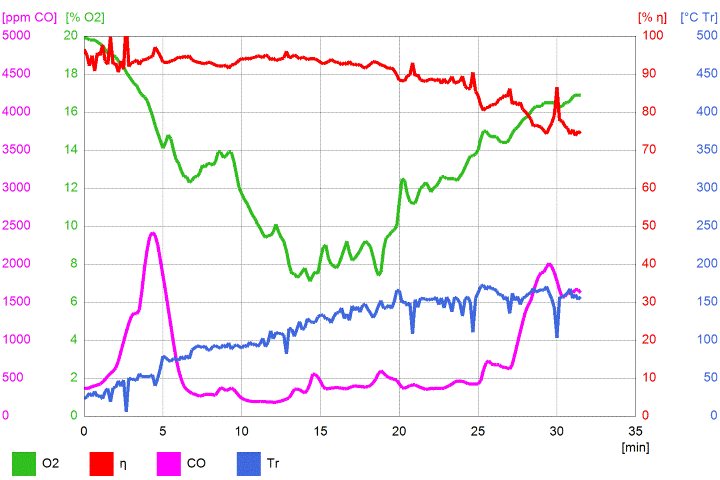 It happened to be a quite windy day, with sudden gusts. Not the best weather for testing, the ordered draft limiter hasn't arrived yet. Next run that day in an almost completely cooled down core, no brick at the bottom and an overhang of 63 mm bringing the opening down to 150%. Same weather, no opaque fireballs this time around. 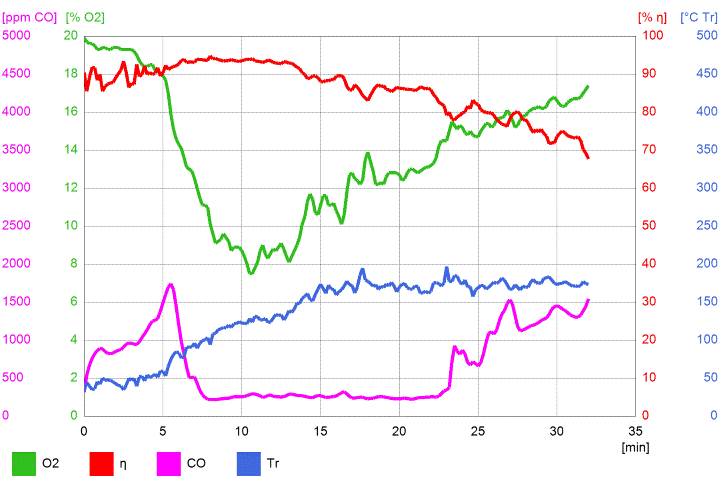 The core looked like this during the top of the burn. Mark that the restriction is a brick on its side, about halfway in the depth of the top box. 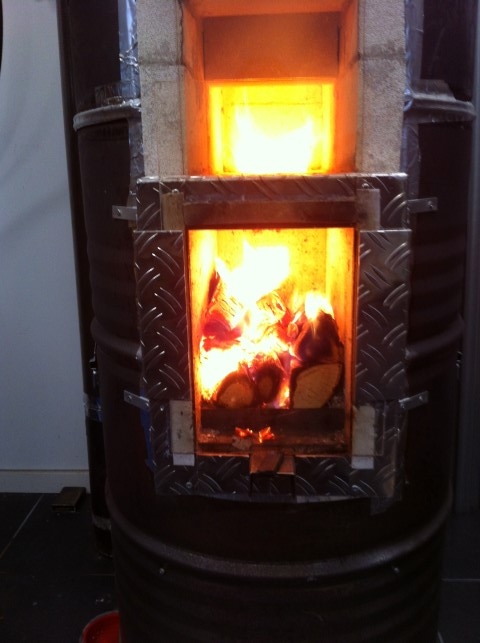 Third run, late night in a cooled down core again. The same configuration as above with an added brick on the floor, bringing the opening down to 110% of the riser's csa. Very good results, remarkably stable. All these runs are done with dry ash or beech. 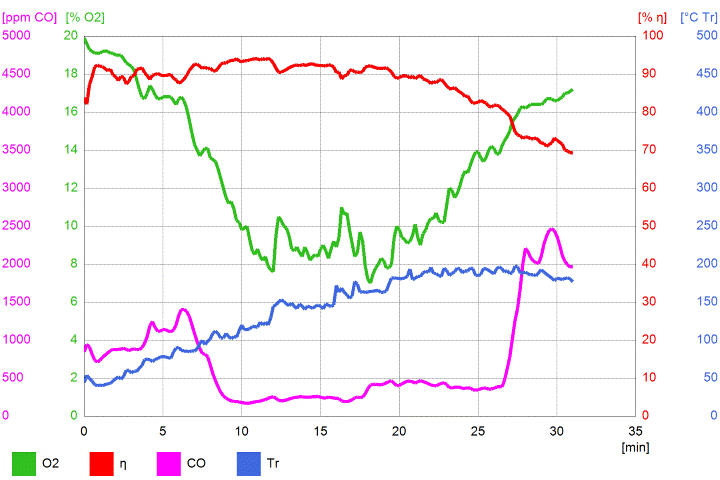 It was quite a spectacular sight to see it run, the picture below doesn't do it justice. While sitting in front of it I needed to go back as far as 2.5 meters (2.7 yards) and it was still scorching hot at that distance. 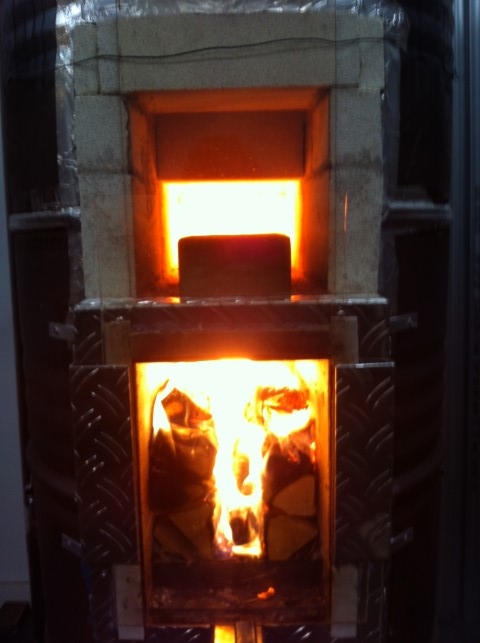 The brick ended completely clean although there had been some soot on it prior to the test. Conclusion so far: those restrictions seems to be vital to get the thing really stable. Resulting opening should be between 150% and 100% which leaves plenty of play for different types of casserole or römertopf. Next goal: do series of testing with and without that brick to find out whether or not these are one-off beautiful results. I'll wait for the draft limiter to arrive so I will be able to eliminate draft differences. |
|
|
|
Post by satamax on Feb 10, 2019 4:07:46 GMT -8
Peter, i can't remember, you have top port in that one, or back port and top box? Back port and top box. As such the bottom half is very much like the Mallorca build, top box as the last one which was yielding the best results so far. Peter, do you think it matters if the top box is perpendicular? I might do a quick mod to the workshop rocket, to make a real oven behind the top window of the workshop heater. I have plenty of normal firebricks for the box. Not the best, but i'll burry those in vermiculite perlite mix. What do i do for the stub chimney on top? 50cm or more? |
|
|
|
Post by peterberg on Feb 10, 2019 8:59:03 GMT -8
Peter, do you think it matters if the top box is perpendicular? Do you mean straight up? Yes, it matters being not horizontally, gas velocities and aerodynamics are very different. In case you mean turning it 90 degrees in the horizontal plane this doesn't matter, as far as I can see. As such, a stub sidewinder with a box on top is also one of the possibilities. Part of the general idea in fact: simple, no fuzz, flexible. I love that. What do i do for the stub chimney on top? 50cm or more? No chimney stub on top, the thing functions perfectly without. Mark this is a very, very tight design, much more than the bog standard straight batchrocket. Please follow my results as close as you can. |
|